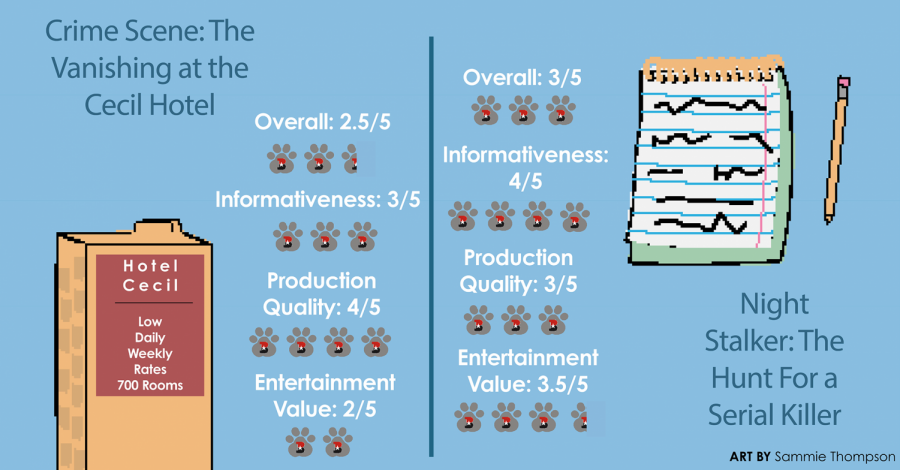Netflix takes on the world of true crime
May 14, 2021
A comprehensive review of two new documentaries: “Night Stalker” and “Crime Scene”
True crime documentaries are a guilty pleasure for many people around the world. They captivate audiences with their unique storytelling and ability to make real, horrifying events seem like works of fiction. In recent years, Netflix has been known for producing high-quality documentaries about high-profile cases. This reputation continued earlier this year, when they released two new documentaries: “Night Stalker: The Hunt For a Serial Killer” and “Crime Scene: The Vanishing at the Cecil Hotel”.
“Night Stalker: The Hunt For a Serial Killer” was released first on Jan. 13. The limited series includes four 50-minute segments which chronologically tell the story of one of the most notorious serial killers in history, Richard Ramirez. Known as the “Night Stalker,” he terrorized neighborhoods in Los Angeles and the surrounding area in the 1980s with a string of murders, kidnappings, and assaults.
This documentary re-frames this well-known story into a new one by highlighting the perspectives of victims, detectives, and journalists that were involved in the Night Stalker case. Two of the lead detectives, Gil Carrillo and Frank Salerno, are the main sources in the documentary, which allows the audience to understand their process of trying to find the killer.
The documentary begins by setting the stage in 1980s Los Angeles, painting the city as a booming, vibrant place with a dark side. It describes the increasing crime at this time, including several strange murders in which witnesses described similar events. Detectives Carrillo and Salerno come to the conclusion that this is a single person committing all of these crimes, but they can never seem to find them. Finally, a single fingerprint and other small clues lead them to Ramirez, and he is captured and arrested.
My initial reaction when watching this documentary was surprise at how much detail was used to describe the Night Stalker’s crimes. A majority of the runtime was dedicated to explaining exactly what happened to his victims and how that led the detectives to find him. There were several graphic pictures and video clips of crime scenes which helped tell the story, however, I would not recommend watching this documentary if that is something you do not want to see.
Additionally, something that immediately caught my attention was the use of randomly added video clips during voice overs or at other breaks in the story. One moment, someone would be answering an important question, and the next, there would be an ominous shot of a random alley or a bullet falling to the ground. I understand that these clips are added to build suspense, but in my opinion, they added nothing to the documentary. There were many instances in which this cliche “true crime” footage was used where something else should have been added that would better help the audience understand what was happening.
Despite these flaws, I still enjoyed watching this documentary and thought that it was informative and captivating. I appreciated that there was a focus on the perspectives of other people involved in the case, especially survivors and family members still seeking justice. As survivors were recounting their terrifying experiences, I could feel their emotion and sincerity through the screen, and I hoped even more that justice would prevail.
The other documentary, “Crime Scene: The Vanishing at the Cecil Hotel” was released on Feb. 10. This documentary also has four parts that are each about an hour long and tell the story of Elisa Lam, a 21-year-old Canadian traveler that mysteriously disappeared at the Cecil Hotel in Los Angeles in early 2013.
This documentary begins by laying out the history of the Cecil Hotel, which has been the location of a wide variety of crimes and is considered to be haunted by some people.
It then discusses who Lam is and how she traveled to the hotel before disappearing in January of 2013. An investigation was immediately set up to find her, but there was almost no trace of where she could be. Eventually, Lam’s body was tragically found in a water tank on the roof. The official cause of her death was determined to be accidental drowning, with her mental health considered a contributing factor, as she had previously been diagnosed with bipolar disorder and depression.
“Crime Scene: The Vanishing at the Cecil Hotel” doesn’t end here, however. There is a focus on what happened after her death, when more and more people learned about this case Online and felt that something wasn’t right. This feeling among Internet users was exacerbated by an infamous video of Lam acting strangely in an elevator before she disappeared. Conspiracy theories were and still are everywhere, ranging from a staged disappearance, foul play by someone staying at the hotel, and even a cover-up by the hotel staff.
This brings me to my least favorite part about this documentary. So much time was spent interviewing random YouTubers on their theories about this case that something vital, in my opinion, was missed: actually getting to know who Lam was. While there were attempts to show the audience her personality through old social media posts, I would’ve liked to see an interview with someone who actually knew her in real life.
Overall, this documentary was decent. It was captivating and even a bit creepy at times, but it was a little too long and drawn-out for me. I also found it interesting that there was actually a connection between this documentary and “Night Stalker: The Hunt For a Serial Killer”, because Richard Ramirez (the “Night Stalker”) was confirmed to have stayed at the Cecil Hotel before he was arrested.
I would recommend watching these two documentaries if you are interested in learning more about these cases and have a couple hours to kill. However, I would not watch either one if you get scared easily, because they can both be pretty disturbing at times. Ultimately, it is important to keep in mind as you are watching that these events are not fictional, but that they happened to real people with real families and friends who may still be seeking justice.








